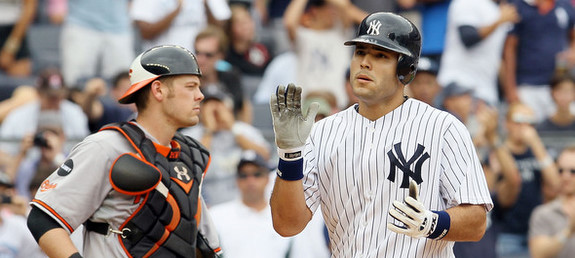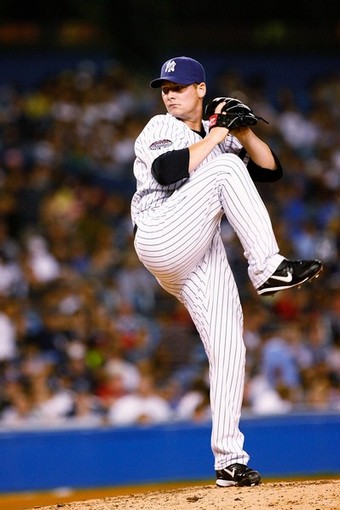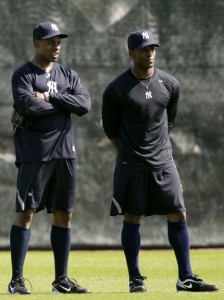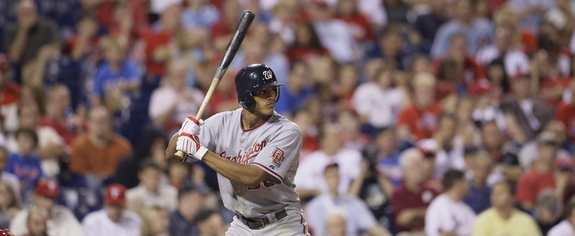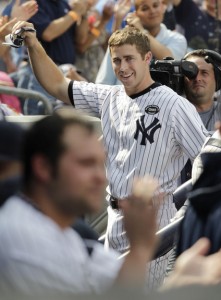
Greg Golson is known to Yankee fans for one incredible throw in 2010. However, despite the greatness of that moment, there was more to his baseball story.
‘Nothing he can’t do’
Golson was drafted 21st overall in the first round of the 2004 MLB Draft by the Phillies. A five-tool prospect, Golson describes himself as not raw but needing development. The Texas high schooler had blazing speed and a cannon of an arm. His bat and power were expected to come along with Baseball America saying “there’s really nothing he can’t do” in their scouting report.
“I had this style of play that was kind of reckless abandon, all out; I think that’s what the Phillies liked about me,” Golson told River Avenue Blues. “But I think I needed to stop thinking so much at the plate.”
Golson slowly worked his way up through the Phillies’ system, hitting as many as 13 home runs in a season and stealing up to 30 bases. He even got a cup of coffee and six at-bats in September for the 2008 World Series champions. However, he couldn’t put it all together before he was traded to Texas after the season. The outfielder was designated for assignment by the Rangers after 2009 and landed with the Yankees in a trade.
Though he would make the Show with the Yankees as well, he never got the opportunity to be a regular, partially due to the misfortune of playing for three teams in the midst of postseason windows.
“I think that’s more, I wouldn’t say to blame, but that’s more of the cause of me not getting an opportunity to play every day,” Golson said. “There was an emphasis on winning once I got up and there was no room for a rookie to figure out his way.”
Wearing Pinstripes
Golson received his first call-up to the Yankees on May 4, playing in one game before getting optioned three days later. He hadn’t been hitting all that well in Triple-A to that point, but Alfredo Aceves hit the shelf with a bulging disk on May 12, getting Golson right back up the to the Majors.
“I’m at my rental property in Scranton and I get a call from my manager saying, ‘Hey, you’re going to the big leagues,'” Golson recalled. “At the time, I was hitting .210, I hadn’t made the adjustment at the plate, so I’m like, “What!? I’m going where? This is a joke, right?”
Though it was 1 a.m. right after a game, Golson quickly got packed with excitement and boarded a plane to Detroit, meeting the Yankees before a game with the Tigers. He was 0-for-7 in his MLB career before the matchup and entered as a defensive replacement for Marcus Thames. In the ninth inning, he got the plate and smacked a single for his first career hit.
Golson remembers getting the clubhouse after the hit, “I wouldn’t say I was walking, I was floating.” His favorite player growing up was Derek Jeter, who came up to him.
“Jeter is like, ‘That’s your first hit, man? We need to celebrate.’ I’m like, ‘Nah, I need to get some sleep.'”
Most people wouldn’t turn down an opportunity to celebrate with Jeter, his childhood hero, to catch some z’s. Instead, Golson recalls Jeter taking the rookie out to eat in Boston, “Not many people get to play with their childhood hero and then they take you out.”
Golson would get into four more games with his first Major League start before getting optioned down on May 17. He’d spend the summer in Scranton and he found his hitting stroke in the process with a solid .263/.313/.414 line despite a slow start.
“Looking back, that was probably the best time of my life. I was just on cloud nine,” he said. “You don’t need Advil, you don’t need any anti-inflammatories. You’re ready to go. Being around so many potential and future Hall of Famers, I learned a lot.”
With expanded rosters, the Bombers called up Golson in September and utilized him almost exclusively as a pinch-runner and defensive replacement. Nick Swisher was slowed by injuries and Brett Gardner also missed some time, creating an opening for Golson.
He went 0-for-2 in stealing bases during the 2010 season, but his defense did all the talking. With the combination of fabulous speed and a rocket arm, he was the perfect man to come in for Swisher, Austin Kearns or whomever manned the corner opposite Gardner.
“A lot of times I was hoping for Nick Swisher or Jorge Posada would get a single or a walk, so I could get into the game. I would never hope [the opponent] would tie it up, but I would just love to get an at-bat.”
Golson wanted the opportunity to show off his swing, spending plenty of time in the cages while in the Majors. Despite his best efforts, it would be a game in which he didn’t bat that gets remembered years later.
The Throw
The Yankees were fighting with the Rays for the AL East crown in 2010 and had a series in Tampa Bay in mid-September with a half-game lead going into it. New York didn’t have pressure to win the division with the wild card in hand. Furthermore, a wild card berth meant facing the Twins instead of the upstart Rangers in the ALDS.
Regardless, the Pinstripers lost Game 1 on a Reid Brignac walk-off homer. Game 2 on Sept. 14 was a wild affair with the Yankees see-sawing from up 6-0 in the top of the 5th inning to down 7-6 after the bottom half, before knotting the game at seven in the sixth.
It stayed that way into extra innings, though Golson entered in the ninth after Juan Miranda pinch hit for right fielder Colin Curtis, who was filling in for Swisher. Despite a desire to start, Golson was primed for filling-in after coming up with a National League team, thereby dealing with pitchers hitting and double switches.
It was just a few days before Golson’s birthday and his brother, who was stationed in Jacksonville, came down to watch him play at the Trop. Therefore, the 25-year-old outfielder was already loose simply with family in town and a Yankees uniform on his back. He came into the series knowing playing time was likely thanks to a lefty-laden Rays staff.
Though he’d done the proper cage work in game, he hadn’t gotten a chance to fully stretch out his arm. That’s where Gardner helped out.
“When I got in, Gardner was in left and he was saying, “Do you need to throw?” because I was throwing with Granderson in center,” Golson recalled. “… We backed up almost foul pole to foul pole and we were just long tossing so I could get my arm loose. It ended up paying off because it was pretty much the same distance that I ended up throwing to third to A-Rod.”
In the top of the 10th, Posada hit a solo home run to put the Yankees up, 8-7. That meant Mariano Rivera would have the chance to close things out in the 10th.
An inauspicious start met Mo with Carl Crawford singling through the right side.
“Once he got on base, I was like, “OK, I’m going to throw him out at home,”” Golson said. “That was the thought process because I always try to think of the toughest play before the play starts so I can have it in my mind in case it happens.”
Evan Longoria, ever the Rivera killer, flew out to deep center for the first out, though Crawford didn’t tag up. Crawford then stole second, though Golson remembers him being out before the ball came out of Jeter’s glove.
Matt Joyce stood at the plate and lifted a fly ball down the line to right, an easy catch for Golson but seemingly far enough to advance Crawford to third. This was, of course, prime Crawford, who stole 46 bags in 2010, down just five steals from a career-best 51 in 2009.
“When the ball went up, I know the first thing I thought was, ‘Just catch it. Don’t worry about getting behind it,'” Golson recalled. “It was going in and out of vision because of the roof.
Ah yes, the Tropicana roof. That explains why Golson ended up flat-footed after the catch instead of getting behind the ball. At the time, he was more worried about recording the first out and not letting the ball get away, thus making him the “butt of a lot of jokes.”
Still, flatfooted or behind the ball, Golson was ready when Crawford tagged up. He nailed the Rays’ speedster on a low line-drive of a throw and a good pick and tag by Alex Rodriguez.
“All I remember is getting high fives after that. I don’t remember anything after the moment but getting high-fives and pointing at A-Rod, saying, “Nice pick.”
Moving Forward and Looking Back
While that was Golson’s shining moment in pinstripes, he did make the Yankees’ postseason roster that fall. He made a shoestring grab to finish off another Rivera save in Game 1 of the ALDS, his only putout and opportunity in three postseason appearances.
The Yankees were eliminated by Golson’s old team, Texas, near where the Austin native grew up. After being designated for assignment and starting 2010 out with struggles at the plate, Golson didn’t expect the ride of the year to end. “Being a part of the postseason roster and playing in front of my family in my home state, on the Yankees.”
He would also briefly play for the 2011 Yankees, finishing with 35 plate appearances over the two seasons with eight hits, two RBI and a .235/.257/.294 batting line.
Golson bounced around between Double-A and Triple-A for the White Sox and Braves in 2012-13 before turning to independent league baseball. As for why he never made it back to The Show, Golson now sees some of what the younger version of himself couldn’t at the time and that he was too willingly pliable to coaches.
“I played with nine different organizations and every single one of them, as soon as I got there, it was, ‘This is what we’re going to do,’ and I had to figure out what worked for me.”
Golson began to figure out more about his game once he got out of affiliated ball, playing in Mexico, Venezuela and the Dominican Republic as well as stateside. Once there, he lost concern for how his game looked and his pedigree as a former first rounder and big leaguer.
“A lot of guys say it, but I really do wish I knew then what I know now.”
The 33-year-old is now finishing up a degree in health and wellness this August. When he first began taking classes online, he made it his goal to play until he got the degree and he’s been in the Atlantic and Mexican Leagues in recent seasons before joining the Texas AirHogs of the American Association last year. He’s a free agent for now, living in Denver and passing some baseball lessons on as an instructor.
Still, he can sometimes struggle to look back on his playing days. As a right-handed player for platoon purposes and coming through the systems of competitive teams, Golson didn’t get the chance he might have had on a rebuilding roster.
Think about it. He got into 40 MLB games and hat 42 plate appearances, something most of us have or will never experience, but it was just that, 40 games, never more than a month at a time. Therefore, Golson has gratitude for being able to live out his dream and play for the Yankees, yet he also wanted more.
“Being on the Yankees comes with that look [from people] of, “Why? Why was he on the Yankees?” That throw is something that people go and look up and they’re always like, “I saw your throw. That was awesome.”
“It’s really cool and it’s the defining moment of my career, so I hear about it a lot and I’m grateful that it happened. Again, I’m not going to say it was an albatross, but I just wish I could have done more with my career so there was more to give people, like I can hit, too.”
